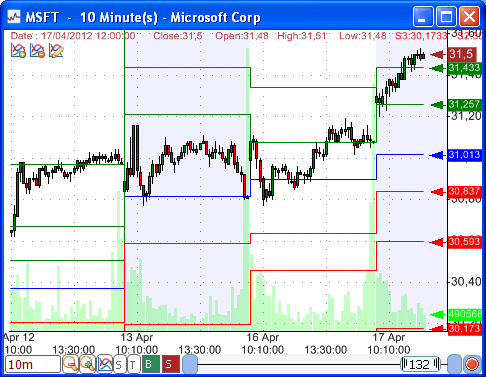Pivot points are support and resistance levels calculated using previous session's data. They were originally used by floor traders to find the market direction during a trading session. Based on the high, low and close values of the previous session, it uses basic calculations to create several resistance and support levels. These levels are known as pivot levels and they are used by so many traders that you will find that the market reacts pretty often at these levels. One of the main advantages of pivot points is that it allows you to predict potential support and resistance areas and therefore know your entries and exits before the start of the next trading session. You can for example choose which assets to trade based on how wide the support/resistance distance is. There are several pivot points versions With the growth of the pivot points popularity, several versions have emerged. Each has its own formula but almost all have the same interpretation. Let us first introduce you to the most popular one, which is simply called classic or floor pivot points: Range = (high - low); PP = (high + low + close) / 3; // Pivot Point R1 = 2 * PP - low; // First resistance R2 = PP + Range; // Second resistance R3 = PP + Range * 2; R4 = PP + Range * 3; S1 = 2 * PP - high; // First support S2 = PP - Range; // Second support S3 = PP - Range * 2; S4 = PP - Range * 3; Based on the above formula, you can clearly see that pivot points calculation is very simple and that it can be applied to any market and any assets including stocks, Forex, ETFs, bonds, futures and commodities... Other versions include Woodie Pivot Points, Camarilla pivot points and Tom DeMark's Pivot Points. Woodie Pivot Points: Unlike the classic version, the Woodie's one uses the open price of the next session to calculate pivot point levels. R4 = R3 + RANGE R3 = H + 2 * (PP - L) R2 = PP + RANGE R1 = (2 * PP) - LOW PP = PP = (HIGH + LOW + 2 * Tomorrow's OPEN) / 4 S1 = (2 * PP) - HIGH S2 = PP - RANGE S3 = L - 2 * (H - PP) S4 = S3 - RANGE Camarilla Pivot Points: Camarilla equation uses close, high and low prices and produces eight levels. This method was discovered by Nick Stott, a bond trader, while he was day trading. R4 = (H−L)×1.1/2+C R3 = (H−L)×1.1/4+C R2 = (H−L)×1.1/6+C R1 = (H−L)×1.1/12+C S1 = C−(H−L)×1.1/12 S2 = C−(H−L)×1.1/6 S3 = C−(H−L)×1.1/4 S4 = C−(H−L)×1.1/2 Tom DeMark's Pivot Points: These are not pivot points exactly, but they can be used to predict tomorrow's low and high (support & resistance). The indicator was created by Tom DeMark. X = H+2×L+C // If Close < Open X = 2×H+L+C // Close > Open X = H+L+2×C; // Close = Open New High = X/2−L New Low = X/2−H QuantShare formula: x = 0; x = iff(close < open, x, high+2*low+close); x = iff(close > open, x, 2*high+low+close); x = iff(close == open, x, high+low+2*close); NewHigh = X/2-low; NewLow = X/2-high; Trading Pivot points There are several ways to trade pivot points. The majority of traders are using them to find good entry and exit levels. The following shows you one set up to trade pivot points: Before the market begins, we analyze several stocks looking for the ones that closed below tomorrow pivot point. Another condition must also be met: Range, in percentage, between the S1 and S2 must be higher than 2%. The daily scanner can be downloaded here: Pivot Point Breakout Scanner It uses the screener tool to analyze stocks looking for the ones that meet the above criteria. One you get your list of stocks, use the following intraday entry and exits to take new short trades. Entry: Price closes below the support line (S1) Exit: Price reaches S2 Stop: Price closes few points above the support line (S1)  There are so many ways to trade pivot points. Here is another one: The market opens between R2 and R3 then crosses R3 line and pulls back. Place an entry order few cents above the resistance line and an exit order few cents below that line. A profit stop order can also be placed at the R4 line. How to plot pivot points in an intraday chart Open an intraday chart. Make sure you have data for at least 2 days. If it not the case then get data using one of the intraday downloader available in QuantShare Sharing Server. Download the following indicator: Floor Traders Pivots then add it to your chart. p = FloorTradersPivots(); plot(p, "FloorTradersPivots", colorBlack, ChartLine, StyleOwnScale);  EOD pivot points based on weekly, monthly and yearly data Besides intraday pivot points, end-of-day ones do exist. Instead of using the previous session data to calculate levels for today, we can use the previous week or month data to create pivot levels that can be applied to the current week or month. Weekly pivot point can be used to predict short-term movements. For medium term predictions, you may use monthly pivot point and for the long-term, you can use yearly pivot point. Using pivot points with other indicators Using other indicators and techniques in combination with pivot points will certainly help you make better trading decisions. It might be a moving average crossover, MACD been in an uptrend or the RSI indicating an oversold area.
|

|
|
|
|







